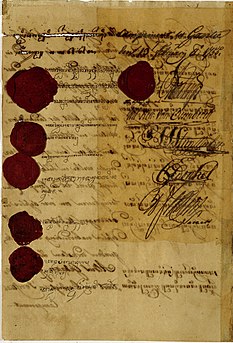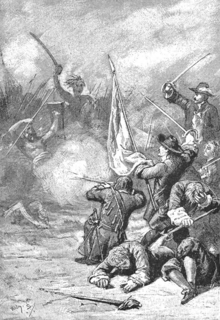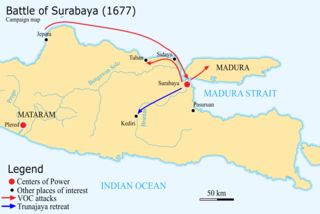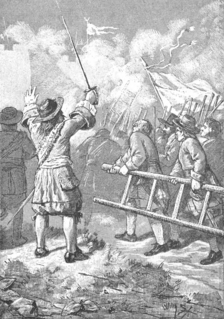Related Research Articles

Madura Island is an Indonesian island off the northeastern coast of Java. The island comprises an area of approximately 4,441.95 km2. Administratively, Madura is part of the province of East Java. It is separated from Java by the narrow Madura Strait. The administered area has a density of 744 people per km2 while main island has a somewhat higher figure of 826 per km2in 2020.

The Sultanate of Mataram was the last major independent Javanese kingdom on the island of Java before it was colonised by the Dutch. It was the dominant political force radiating from the interior of Central Java from the late 16th century until the beginning of the 18th century.

Sultan Anyakrakusuma is known as Sultan Agung was the third Sultan of Mataram in Central Java ruling from 1613 to 1645. A skilled soldier he conquered neighbouring states and expanded and consolidated his kingdom to its greatest territorial and military power.

Hamengkubuwono I, born Raden Mas Sujana, was the first sultan of Yogyakarta, reigning between 1755 and 1792.

Amangkurat II was the Susuhunan of Mataram from 1677 to 1703. Prior to taking the throne, he was the crown prince and had the title Pangeran Adipati Anom.

The Treaty of Giyanti was signed and ratified on February 13, 1755 between Prince Mangkubumi, the Dutch East India Company, and Sunan Pakubuwono III along with his allies. The accord officially divided the Sultanate of Mataram between Mangkubumi and Pakubuwono. The name "Giyanti" was taken from the location of the signing of the agreement, namely in Giyanti Village which is now located in Hamlet Kerten, Jantiharjo Village, southeast of Karanganyar, Central Java.

The Dutch East India Company had a presence in the Malay Archipelago from 1610, when the first trading post was established, to 1800, when the bankrupt company was dissolved, and its possessions nationalised as the Dutch East Indies. By then it exerted territorial control over much of the archipelago, most notably on Java.

Surakarta Sunanate was a Javanese monarchy centred in the city of Surakarta, in the province of Central Java, Indonesia.
The Java War of 1741 to 1743 was an armed struggle by a joint Chinese and Javanese army against the Dutch East India Company and pro-Dutch Javanese that took place in central and eastern Java. Ending in victory for the Dutch, the war led to the fall of the Sultanate of Mataram and, indirectly, the founding of both the Sunanate of Surakarta and the Sultanate of Yogyakarta.
The First Javanese War of Succession was a struggle between Sultan Amangkurat III of Mataram and the Dutch East India Company who supported the claim of the Sultan's uncle, Pangeran Puger to the throne.
The Mataram conquest of Surabaya or Mataram-Surabaya War was a military campaign by the Sultanate of Mataram in the early 17th century that resulted in the capture of the Duchy of Surabaya and its allies in eastern Java, in modern-day Indonesia. Prior to this conquest, Mataram and Surabaya were rivals for power in central and eastern Java. The campaign began in 1614 when Mataram, under the leadership of Sultan Agung, attacked Surabaya's allies, including Wirasaba. Surabaya and its allies launched a counterattack but were defeated near Pajang in 1616. Over the next few years, Mataram gradually conquered members of the Surabayan alliance, and by 1620, the city of Surabaya itself was under siege, holding out until it surrendered in 1625. With this conquest, Mataram unified most of central and eastern Java under its control, and cemented its position as the dominant power in Java. Surabaya and other conquered areas would remain in Mataram's hands until it was ceded to the Dutch East India Company in 1743.

The eastern salient of Java is a region that makes up the easternmost part of the island of Java, Indonesia. It is not a formal or administrative subdivision, but rather a designation often used to refer to its distinct history, culture, and geographical feature. It is generally considered to begin in the Tengger mountain range and extend eastwards to the east coast of Java. It is entirely contained by the Indonesian province of East Java.
The Duchy of Surabaya was a Javanese principality centered in Surabaya, on the northeastern coast of Java, that existed as an independent polity from c. 1546 to 1625. It became independent following the disintegration of the Demak Sultanate, and by the beginning of the 17th century had become the leading power in east Java and the most important port on Java's northeastern coast. Subsequently, it entered into decades of conflict with the Mataram Sultanate that ended in the victory of Mataram and the fall of Surabaya in 1625.

The Trunajaya rebellion or Trunajaya War was the ultimately unsuccessful rebellion waged by the Madurese prince Trunajaya and fighters from Makassar against the Mataram Sultanate and its Dutch East India Company (VOC) supporters in Java during the 1670s.

The Battle of Surabaya was fought in May 1677 during the Trunajaya rebellion, in which the Dutch East India Company defeated the forces of Trunajaya and took Surabaya on behalf of its ally, the Mataram Sultanate.
The Fall of Plered was the capture of the capital of the Mataram Sultanate by the rebel forces loyal to Trunajaya in late June 1677. The attack on Plered followed a series of rebel victory, notably in the Battle of Gegodog and the fall of most of Mataram's northern coast. The aged and sick King Amangkurat I and his sons offered an ineffective defense, and the rebel overran the capital on or around 28 June. The capital was plundered and its wealth taken to the rebel capital in Kediri. The loss of the capital led to the collapse of the Mataram government and the flight of the royal family. The king fled with his son the crown prince and a small retinue to Tegal and died there, passing the kingship to the crown prince, now titled Amangkurat II, without any army or treasury.
The Battle of Gegodog took place in 13 October 1676 during the Trunajaya rebellion, and resulted in the victory of the rebel forces over the Mataram army led by the Crown Prince Pangeran Adipati Anom. Gegodog is located in the northeastern coast of Java, east of Tuban.
After his victory at the Battle of Gegodog in northeast Java, the Madurese rebel leader Trunajaya proceeded westwards to conquer Mataram Sultanate's remaining towns on the north coast of Java. By January 1677, nearly all coastal towns from Surabaya to Cirebon were taken.
I Maninrori Kare Tojeng, also known as Karaeng Galesong, was a Makassarese nobleman and warrior, and a major leader of the Trunajaya rebellion in Java against the Mataram Sultanate. He participated in the successful invasion of East Java and the subsequent rebel victory at Battle of Gegodog (1676). He later broke out with Trunajaya, and built a stronghold in Kakaper, East Java. Dutch East India Company (VOC) and Bugis forces took Kakaper in October 1679, but Galesong escaped and rejoined Trunajaya. He died on 21 November 1679, either by illness or murdered by Trunajaya, before the rebellion ended.

The 1678 Kediri campaign took place from August to December 1678 in Kediri during the Trunajaya rebellion. The forces of the Mataram Sultanate, led by Amangkurat II, and the Dutch East India Company (VOC), led by Anthonio Hurdt, marched inland into eastern Java against Trunajaya's forces. After a series of marches beset by logistical difficulties and harassment by Trunajaya's forces, the Mataram–VOC army crossed the Brantas River on the night of 16–17 November. They then marched on Trunajaya's capital and stronghold at Kediri and took it by direct assault on 25 November. Kediri was plundered by the Dutch and Javanese victors, and the Mataram treasury—captured by Trunajaya after his victory at Plered—was completely lost in the looting. Trunajaya himself fled Kediri and continued his greatly weakened rebellion until his capture at the end of 1679.
References
- 1 2 3 Ricklefs, Merle (2018). Soul Catcher: Java's Fiery Prince Mangkunagara I, 1726-95. NUS Press. ISBN 9789814722841.
- 1 2 3 4 5 Ricklefs, M. C. (2008). A History of Modern Indonesia since c.1200. Macmillan International Higher Education. ISBN 9781137149183.
- 1 2 3 4 Choy, Lee Khoon (1999-06-02). Fragile Nation, A: The Indonesian Crisis. World Scientific. ISBN 9789814494526.